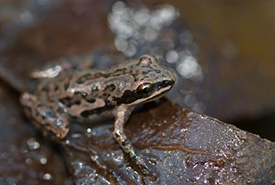
Western chorus frog (Photo by Josh Vandermeulen, Creative Commons)
Western chorus frog
What does this species look like?
The average length of a western chorus frog is 2.5 centimetres. The smallest frog species in Quebec, some can fit on the tip of a human finger! Like other frog species, females are slightly larger than males.
Its colour varies from pale grey to dark brown tinged with olive green. This species can be recognized by the dark stripe running from its snout, across its eyes and disappearing near its groin, as well as the three dark stripes (sometimes dots) on its back.
No western chorus frog description is complete without mentioning its song. This tiny frog has a distinctive call, similar to the sound made by a fingernail rubbing against a comb. At mating time, from April to mid-May, its call is the first to be heard among other frog species.
Listen to the chorus frog song here (webpage in French).
Where does this species live?
Western chorus frogs are limited to North America. In Canada, they are found in southern Ontario and two regions of Quebec: Montérégie and Outaouais. Both regions are subject to strong pressures from property development and farming practices intensification, which involves an increased usage of pesticides, damaging western chorus frogs’ habitats.
Western chorus frogs primarily breed in temporary, shallow wetlands known as vernal pools. Once the tadpole is sufficiently developed, it emerges from the water and adopts the surrounding terrestrial habitat: woodland, fallow land, meadow or pasture. In winter, these frogs hibernate under rocks, dead trees or leaves.
What is the conservation status of this species?
The Great Lakes/St. Lawrence and Canadian Shield population, which includes individuals from Quebec and some from Ontario, is designated as nationally threatened. The Carolinian population, which includes individuals from southwestern Ontario, is considered to not be at risk.
Long designated as vulnerable in Quebec, the species has been considered threatened in the province since 2022. The destruction of its habitat by urbanization is one of the main threats it faces.
Click here to view a map of the western chorus frog's fragmented habitat distribution in the province of Quebec (webpage in French).
What is NCC doing to protect habitat for this species?
Western Chorus frog populations have been in steep decline since the 1950s, but it is still possible to help them. The Nature Conservancy of Canada (NCC) and our partners protect a number of lands that include habitats suitable for this species.
In Quebec:
- Breckenridge Creek, Outaouais region
- Breckenridge Ecological Corridor, Outaouais region
In Ontario:
- Carden Alvar Natural Area, northeast of Lake Simcoe
- Happy Valley Forest – Pottageville Swamp Natural Area, Greater Toronto Area
How you can help
The western chorus frog website is an initiative of several partners (including NCC) and where you can find out more about the species, the various ways you can help it and about the natural environments of southern Quebec. You can also sign up for the Western Chorus Frog Ambassadors Program launched as part of the recovery plan for the species, led by the Ministère des Forêts, de la Faune et des Parcs. Its aim is to rally both citizens and organizations that are looking to learn more about this amphibian and to share information, to raise awareness and to act concretely in conservation and perception efforts.
Visit chorusfrog.ca/ for more information.





